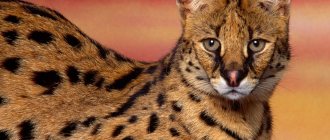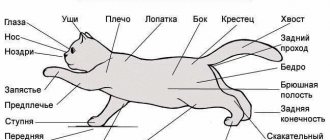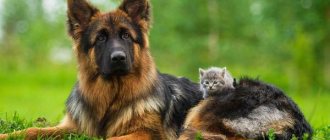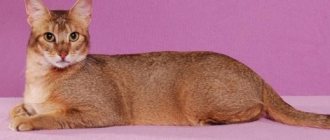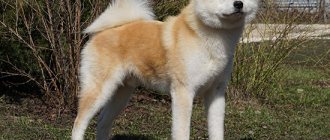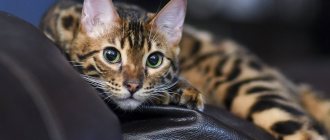History of the origin of the Don sphinxes
Don Sphynxes are a very young breed. Their story began in the recent 80s of the 20th century in Rostov-on-Don. Having picked up a kitten on the street that was no different from the rest, the owner after a while noticed that her pet began to go bald. First the hair disappeared on the head, then on the back. Veterinarians assumed that the cat, whose name was Varvara, was sick and tried to treat her. But the pet’s health was good; Varya did not show any signs of illness.
After 2 years, in 1988, the owner decided to show her favorite to felinologists (specialists in domestic cats). It was then that Irina Nemykina turned her attention to her, who remembered an article she had read in a magazine some time ago that a new hairless breed of cats had been bred in America, which was called the Sphynx. It was Irina who suggested that Varvara’s offspring could have the same appearance as their mother’s.
Another 2 years later, Varvara gave birth to three kittens, whose father was a European shorthair cat. One kitten, named Chita, lost almost all of its fur as it grew older. Only the paws and tail remained bare. Chita was given to Irina, who decided to seriously start breeding a new breed.
It is Chita who is the founder of the Don Sphynx breed.
In 1991, 4 kittens were born from Chita. They weren't completely naked. Their skin was covered with light fur, but it was still difficult to call it full. This type of sphinx is called a brush. Having founded a nursery called “Myth”, Irina Nemykina continued to work on breeding cats that could be called sphinxes. For a long time, Chita gave birth to kittens with fur. Over time, many of them lost it. Deciding to carry out inbreeding (mating related animals, in this case - mother and son), Irina for the first time received a kitten that was born immediately without hair, that is, naked-born.
For the first time, representatives of the Don Sphynx breed participated in an exhibition in Moscow in 1993. In 1997, a breed standard was adopted. And in 1998, the Don sphinxes received worldwide recognition.
The cat Varvara is the ancestor of the Don Sphynx
How are they different from other breeds?
Non-specialists often confuse the Don Sphynx with the Canadian Sphynx. These are two completely different breeds, but how can you tell them apart? Let's make a comparison. Among the most striking external differences:
Comparison of three similar breeds
Canadian Sphynx
- the shape of the “Canadian’s” head is round, less prominent than Donchak’s wedge-shaped muzzle with pronounced cheekbones and chin;
- the body of the overseas sphinx is strong, muscular with a wide, rounded sternum;
- the limbs of the Canadian hairless cat are longer and more powerful;
- the “Canadian’s” eyes are round, with a green iris, while the “Donetsk” ones are almond-shaped, any color is acceptable;
- The ears are large and wide in both breeds; in the Canadian they do not have rounded tips.
For Canadian Sphynx cats, only one type of coat is acceptable - short, inconspicuous hair, which feels like suede to the touch. These kittens are not born naked; they lose hair as they grow older.
The main difference between the two breeds is that different genes are responsible for their “baldness.” Among “Canadians” it is recessive, that is, both parents must be born hairless kittens without fur.
The Don Sphynx is always a carrier of the dominant gene. Even from mating with a “hairy” cat, hairless individuals will be born. People often ask, is it possible to cross them?
Due to genetic differences, crossing the Canadian and Don Sphynx is strictly prohibited!
It's difficult to say who is better to choose. The undoubted advantages of donchak are a healthier heart and stronger immunity, which makes it less vulnerable to the harmful effects of viruses.
Peterbald
Another similar breed is the Peterbald (Petersburg Sphynx). She was bred during the process of improving the Don variety of hairless cats. As a result of breeding activities, elegant cats with light, elongated bones and thin long limbs appeared. The calling card of the breed is its huge, very wide ears at the base. They are set low and spread out to the sides. Breeding Peterbald with other breeds of Sphynx is also unacceptable.
Despite the differences in appearance, hairless cats have similar personalities. All of them, Elf, Minskin, Dwelf, Ukrainian Levkoy, and Bambino, are affectionate, friendly, and focused on communicating with people.
Description of appearance
The Don Sphynx is a medium-sized cat. The height at the withers is about 30 cm. The weight of a female varies from 3.5 to 5 kg, and that of a male - up to 7 kg.
According to the degree of baldness, there are 4 types of Don Sphynxes:
- Completely naked. There is no fur at all. The body is hot and sticky to the touch, like rubber, covered with numerous folds. Kittens become bald either in the womb or 2–3 days after birth.
- Flock. The coat is very short and soft. It's very difficult to see. The skin feels like a peach. These kittens become completely hairless by about 2 years of age.
- Velours. Compared to flock wool, velor is characterized by longer hairs. They are approximately 2–3 mm long and can already be seen. As they grow older, the fur may disappear completely.
- Brush. The skin of such cats is covered with hard, sparse, rather long hair, which is distributed unevenly throughout the body. Quite extensive areas of baldness may be present and are usually located on the back, neck and head. At exhibitions, such individuals do not receive prizes, but they are often used for breeding.
Photo gallery: varieties of Don Sphynxes by degree of baldness
It is very difficult to distinguish the flock fur of the Don Sphynx with the naked eye.
The skin of naked Don Sphynxes resembles hot rubber
Don Sphynx Brush is used for breeding
Breed standard
The breed standard characterizes the Don Sphynx with the following parameters:
- The head is wedge-shaped. Cheekbones and eyebrows stand out clearly. The forehead is flat, with folds. The nose is straight. The whisker pads are clearly visible.
- The ears are wide. Wide set. The ends are rounded. On the outside, the line of the ears extends beyond the border of the cheeks.
- The eyes are medium-sized, almond-shaped. Not wide open. The color of the iris can be any.
- The body is muscular and strong. The back is straight. The posture is graceful.
- The limbs are thin and long. The pads of the fingers are oblong, the fingers appear elongated and thin.
- The tail is straight and long.
- The skin is elastic. There are folds on the head, neck, armpits and groin. In kittens, the muzzle may have an “ear muff” - short, thin hair that lengthens in the cheek area and the base of the ears. Often in winter, sphinxes develop fluff all over their bodies.
- The color, which in the complete absence of hair is determined by the pigmentation of the skin, can be anything.
The following signs are defects:
- short, round or narrow head;
- small or low set ears;
- Round eyes;
- short, light, weak body;
- short or incorrectly ending tail;
- complete pubescence of the body;
- undershot up to 2 mm.
Turning up of the eyelids and obvious underbite are considered a defect; such individuals are removed from breeding and do not participate in exhibitions.
What is the difference between the Don and Canadian Sphynxes?
First of all, the differences lie in the history of origin of the breeds. Don Sphynxes appeared quite recently, while Canadian hairless cats have been known for a very long time. Externally they also differ:
- Canadian Sphynxes are covered with fluff that is barely noticeable to the eye, while Don Sphynxes can be completely naked.
- The head of Don cats is wedge-shaped, while that of Canadian cats is round.
- The cheekbones and eyebrows of the Don Sphynx are clearly visible on the muzzle, while in the Canadian Sphynx they are smoother.
- The eyes of the Don Sphynx are slanting, almond-shaped, and medium in size, while those of the Canadian Sphynx are large and oval.
- The ears of Russian Sphynxes end in rounded tips, while those of Canadians are sharper.
- Donetsk residents have a stronger physique than Canadians.
- Canadian Sphynxes may have a tassel on their tail, which Don Hairless cats cannot have. Canadians also have a tail that tapers to a point.
- Canadians have more wrinkled skin, especially on the neck and armpits.
The Canadian and Don Sphynxes differ in both appearance and character.
These breeds also differ in character: Don Sphynxes are more cheerful and curious, but Canadians can be reserved and harsh, but in general they are also quite peaceful. The health of Russian hairless cats is better, while the Canadian Sphynxes cannot boast of it.
Differences between the Don sphinxes and the St. Petersburg sphinxes
Among hairless cats, the Peterbald breed is also distinguished. She appeared in St. Petersburg (hence the name) as a result of crossing the Don Sphynx and an Oriental cat. Peterbalds can be distinguished from Donchak by the following characteristics:
- in Peterbalds, the ears are set lower on the head and the tips do not look up, but slightly to the side; in fact, because of this position, the shape of the Peterbald’s head is even more wedge-shaped;
- the head of the St. Petersburg sphinx is comparable to some extent with the head of a snake, it is flat and narrow, with a straight profile;
- Peterbalds have fewer folds on their body;
- It is the St. Petersburg sphinxes that are characterized by thin, slender legs, and they themselves are graceful, thin and “transparent”.
Peterbalds - thin and graceful
What are the varieties and their differences?
Depending on the length of the hair, experts distinguish four types of Don Sphynxes:
Darker colors
Naked
Unites completely hairless cats. They are considered the most exotic and valuable. They are not crossed with each other due to the high risk of giving birth to non-viable offspring. For knitting, folk or velor varieties are selected.
The skin type of these cats varies. In some cats it is dry and smooth, in others it feels like sticky rubber. At the same time, unlike Kohona, there are still small hairs on the body.
Folk
Flock
This type of breed can already be called hairless with a big stretch, since their body is covered with short, thin hair, similar to the fluff on a peach fruit. The densest fur is usually located on the tail and paws.
Usually, if there are no genetic abnormalities, by the age of two the hairs fall out and then the cat takes on the appearance of a hairless Don Sphynx.
Velours
Velours
A type of sphinx with hair reaching a length of 2-3 mm. It’s harder to call such cats beautiful. Outwardly, they look like ordinary yard cats that have suddenly gone bald.
In most cases, such pets also become completely bald with age, but sometimes the hair remains for life.
The velor variety still takes part in breeding.
Brush
Brush
Cats with hard, sparse, short, bristle-like hair. Brush Donchaks, unfortunately, do not take part in exhibitions, which does not prevent them from being excellent domestic cats.
At the same time, they are allowed for breeding. They are crossed with other Sphynx subspecies to improve the health of the breed.
There are even lovers of this particular variety who are not at all embarrassed by the pet’s lack of exhibition prospects
The character and behavior of the Don Sphynxes
These clean cats are distinguished by their good-natured disposition, lack of aggressiveness and affection for humans. Don Sphynxes consider themselves full members of the family. They love active games, so your pet should have toys so that he can splash out his energy. But at the same time, they are not averse to being lazy. Their favorite pastime is dozing, curled up in a ball.
In the absence of attention from the owner, these cats intrusively make themselves known. But the Don Sphynxes are very smart. They are easy to train and get used to the tray. Among the household members, they single out the owner, who is shown more signs of attention than other family members. They get along very well with children and other pets. The attitude towards strangers is also calm. The Don Sphynx very quickly shows its trust to guests by climbing onto their laps.
With all this, the Don Sphynxes know how to take offense at their owners. Fortunately, they do not disturb the order in the house with their revenge, but they can look reproachfully straight into the eyes of their owner for a long time.
It is believed that sphinxes have maximum healing power. Even the ancient Egyptians noticed that touching a hairless cat relieves fatigue and stress.
The Don Sphynx is a very kind and playful breed.
Dimensions and parameters
Don Sphynxes are medium-sized breeds. Their height on average is 25-30 cm at the withers. The cats look much larger and more powerful than the thin, graceful cats.
The weight of a female sphinx is 3.5-5 kg; male – 5-7 kg. Owners should remember that neutered pets gain weight faster; they need to be careful to ensure that the cat does not overeat and moves more.
The body temperature of Don Sphynxes ranges from 38.0–39.5°C. Due to the fact that they have no hair, when you touch the skin, the cat seems to be hot.
Health
In general, Don Sphynxes have fairly good health, but there are some nuances that the owner of these hairless purrs should know:
- the lack of fur makes these cats susceptible to frequent colds, especially when exposed to drafts;
Don Sphynxes should be protected from cold and drafts
- Diseases such as entropion of the eyelids, curvature of the tail, mammary gland cysts, acne (inflammation of the sebaceous glands) are not uncommon for Don Sphynxes;
- Animals may develop an allergic rash on their body;
- If you don't take proper care of your eyes, they can become inflamed.
The average life expectancy of the Don Sphynx is 12–15 years.
Colors
Don Sphynxes can have any color. Smoky, reddish, bluish, red, white - in general, whatever. Even tabby color is allowed, the only caveat is that cats with this appearance are grouped into a separate subspecies.
In the photo the Don Sphynx colors: smoky, red tabby and white
How to choose a Don Sphynx kitten
When choosing a kitten, first of all you should decide what your goals are for purchasing this animal. Brush sphinxes cannot receive awards at exhibitions, but in procreation you cannot do without them. Therefore, if the future owner has a desire to participate in exhibitions for the sake of winning, then he should purchase velor, flock or completely hairless kittens.
The optimal age for purchasing a kitten is three months. Some breeders claim that you can buy a baby 1–2 months after birth. But kittens at this age are still very attached to their mother, so it is better to purchase them a little later. In addition, by this time most of the characteristics of the breed will be clearly visible. Hairless Don Sphynxes are usually born like this right away. In the amniotic fluid you can even find hairs that they shed in the womb. Velor and flock kittens are born with sparse fur, which they shed after a while. Brushes can be born quite hairy and acquire the characteristic coat only in adulthood. It should be noted that a kitten’s appearance may change with age. Over time, a brush can become velor or completely bare, while velor can become flocked. Naked kittens in the winter can acquire short fluff, which disappears with the onset of heat. It can take from 2 months to 2 years for the pet to take on its permanent appearance.
It is better to buy Don Sphynx kittens no earlier than three months of age.
It is interesting that the eyes of Don Sphynx kittens with fur open on the 2-3rd day after birth, and naked-born ones are born with their eyes already open.
When examining Don kittens, you need to pay attention to the same criteria as when purchasing any other kitten:
- the baby should be playful and curious;
- the stomach should not be bloated;
- eyes and ears must be clean;
- teeth - white and even.
It is best to purchase an animal from reputable nurseries . You can also buy a kitten at the exhibition. But purchasing a Sphinx secondhand on the market can result in disappointment. Buying an animal from a pet store is also not the best option, since such cats spend a lot of time in cages and, accordingly, are less socialized and are not potty trained.
The kitten's appearance must meet the standard. In order not to confuse the Don Sphynx with the Canadian one, you need to pay attention to the shape of the eyes (it should be almond-shaped), the ears should be wide with rounded tips, and the body should be pear-shaped.
The cost of kittens directly depends on the purpose for which the animal is purchased:
- If a kitten is bought for the soul, then on the Internet you can find a price from 7-8 thousand rubles. Such animals usually belong to the pet class, that is, they do not participate in exhibitions or breeding due to any non-compliance with the standard. These are the most inexpensive individuals. Also, brush kittens are usually much cheaper.
- Breed class cats are suitable for further breeding. The appearance of such animals deviates slightly from the standards, and they usually do not receive high places at exhibitions. But they are ideal for breeding. Kittens of this class cost from 15 thousand rubles.
- The most expensive animals are representatives of the show class, which compete for prizes. Their cost starts from 35 thousand rubles.
There is an opinion that hairless cats are absolutely non-allergenic. Therefore, allergy sufferers often choose the Sphynx as a pet. In most cases, people who suffer from allergies to animal fur do not have an allergic reaction to Sphynx cats. But this does not always happen. Therefore, before buying a Don Sphynx, first visit people who have such a cat and monitor your reaction to this visit.
Advantages and disadvantages
- High intellectual abilities.
- Affectionate.
- Playful.
- They treat children well.
- Not vindictive.
- No fur, no shedding.
- Suitable for training.
- Do not iron, the skin is very sensitive.
- Due to the high temperature, they “sweat” a lot.
- Complete dependence on a person.
- They hardly chew food; it is necessary to monitor the size of food pieces.
- They eat more than other breeds.
- Demanding on ambient temperature.
How to care for the Don Sphynx
Caring for the Don Sphynx is not as difficult as it might seem at first glance. Your pet's eyes require special attention due to their lack of eyelashes. They should be regularly wiped with a cotton pad moistened with boiled water, chamomile infusion, saline solution, furatsilin solution (1:5000), a faint pink solution of potassium permanganate, “sleeping” tea or special means. This procedure must be carried out 2-3 times a week.
If your eyes are red, you can use Maxidin or Anandin drops. They are instilled into the eyes, 1-2 drops 2-3 times a day for no longer than 2 weeks. If there is no therapeutic effect or if the animal’s condition worsens (swelling of the eye, the appearance of purulent discharge), it is necessary to consult a veterinarian.
Before using Maxidin, it is advisable to consult a veterinarian
Don Sphynxes are bathed more often than ordinary cats: 1–2 times a month. The procedure can be carried out as contamination occurs. Sphynxes with light colors have to be washed more often, those with dark colors - less often. To do this, you need to use mild detergents or special shampoos designed for hairless cat breeds.
There are special shampoos for hairless cats.
It is also necessary to wipe the animal’s skin weekly with a soft cloth moistened with warm water or damp alcohol-free wipes. It is imperative to thoroughly wash each fold, as dirt and sweat can accumulate in them, which, in the absence of proper hygiene measures, often leads to inflammation.
Water procedures should be carried out in a well-heated room, the water temperature should be about 38°. After bathing the sphinx, wipe it dry, apply baby cream and wrap it in a warm blanket. It is extremely important to prevent the animal from being in a draft, as it may catch a cold. Under no circumstances should you use a hairdryer to dry your Sphynx, as this can cause skin burns. There is no need to comb the Don Sphynx.
If the apartment is cool, then the animal needs to be dressed after water treatments and drying.
The Sphynx's skin is exposed to ultraviolet radiation, so when going outside it is recommended to use children's sunscreen or special creams to protect the animal's skin from the sun's rays.
Nails should be trimmed as needed. To avoid the appearance of tartar, it is recommended to brush your teeth several times a week. Ears require regular inspection and cleaning. Veterinarians recommend doing this once every 7-10 days.
Water procedures, ear cleaning, eye washing and claw trimming are accepted calmly by the Don Sphynx, provided that the animal has been accustomed to this from early childhood.
Water procedures of the Don Sphynx should be regular
Toilet
Tray training for Don Sphynxes usually occurs without difficulty. But you need to make sure that the toilet is always clean, since Sphynx cats will not go into a dirty litter box.
For the Don Sphynx it is better to choose a plastic toilet. It does not absorb odors, is easy to clean, and does not rattle when used for its intended purpose. Any filler can be used. The main thing is that the cat likes it. In addition, their choice is quite large: wood, clay, silica gel, etc.
From my own experience and the experience of friends, I can say that not all litters are liked by one or another cat. Relatives had a cat who relieved himself only on the newspaper. And since this litter is not very hygienic (the cat leaves with wet paws, the smell is not absorbed), the owners of the animal decided to purchase a special clumping one. But the cat flatly refused to accept such a change and simply did his dirty cat business next to the tray. I had a similar story. My lovely Persian cat Vasilisa preferred only sand. But she didn’t recognize other fillers. So experiment. Choose what your cat likes. In any case, it is at an early age that the kitten gets used to the conditions offered to it by its owners.
The tray size should not be small. There must be free space for the sphinx so that it can perform the burying ritual. Trays about 40 cm long, 10–15 cm high and 35–38 cm wide are suitable for them.
Features of health, diseases, what causes people to die
The breed is quite young, so initial mistakes in breeding are still clearly affecting the health of the Don Sphynx.
These cats are genetically predisposed to pathologies such as:
- eczema;
- underdevelopment of the eyeball;
- skin vasculitis;
- congenital entropion of the eyelid;
- curvature of the caudal spine;
- nipple hyperplasia (in females);
- dermatitis;
- mammary cyst, most often found in tortoiseshell cats;
- conjunctivitis;
- shortening of the lower jaw. Donchak people with this anomaly are not able to eat properly and constantly damage the roof of their mouth with their teeth.
Donetsk people are protected from major infectious diseases by vaccination. The first vaccination is given to a kitten at two months of age; after 2-4 weeks, revaccination is carried out. At six months, a re-vaccination with a complex drug is prescribed, the procedure is repeated at 12 months, then the cat is vaccinated annually.
Donchaks must be protected from hypothermia (in winter they can catch a cold even in an apartment). In summer, pets' skin should be treated with sunscreen to prevent burns.
How to feed the Don Sphynx
The lack of a full coat is the reason that Sphynx cats, compared to other cat breeds, consume more food to maintain optimal body temperature. They have increased energy exchange and high heat transfer. Accordingly, they consume more calories.
You can feed your pet prepared food and natural food. Don Sphynxes are suitable only for ready-made premium and super-premium food.
Some manufacturers have special food for sphinxes
Natural products in a cat’s diet must include the following components:
- meat (beef, poultry, lamb);
- fish (exclusively sea, raw or boiled);
- eggs (chicken, quail);
- vegetables;
- grain crops (all types of cereals are allowed);
- dairy products (milk, sour cream, cottage cheese, kefir, hard and low-fat cheese, yogurt and others);
- offal (liver, heart, lung, udder, you can use chicken necks, heads, hearts, liver raw, but you need to be sure of their quality level);
- soups (broths).
It is forbidden to give your cat the following food:
- raw river fish;
- bones (tubular bird, rabbit and fish);
- fatty pork or poultry meat and lard;
- smoked, salted and spicy products;
- sweets and baked goods;
- dog food, it does not meet the needs of the cat;
- products containing chocolate, as they can have a toxic effect on the cat;
- leftover food from its table, because the animal gets used to choosing food and refuses its usual food.
In some sources you can find information about the combination of ready-made feed and natural nutrition. Not all experts believe that this is acceptable. I also don’t think this is correct, since in such a situation it is very difficult to find a balance between proteins, fats, carbohydrates and overall calorie content. Therefore, I would not recommend this way of eating. In any case, every controversial issue needs to be resolved with a veterinarian, who will help you correctly prepare your pet’s diet.
The serving size should be calculated individually, based on the activity of the animal, its condition and age. A veterinarian will help you do this. The frequency of feeding depends on the age of the pet. Up to 5 months he is fed 4-5 times a day. After six months, the number of feedings is reduced to 3-4 times a day. An adult cat is also fed 3-4 times a day, while for most representatives of other breeds two meals a day are sufficient. It is very important not to overfeed Sphynx cats, as they are prone to obesity.
Donchak cats do not refuse to try food that is unusual for other cats.
Like any other pet, the Don Sphynx must have access to clean water. Bottled, filtered or spring water is suitable for him.
Breeding
The female Don Sphynx reaches sexual maturity at the age of about 6 months. That's when the first heat comes. But mating cannot be planned for this time, since the cat’s body is not yet ready for motherhood. The 3rd estrus is optimal for conception. Cats become sexually mature only at 8 months. But they are not ready for mating yet. The optimal age for fertilization for both females and males is considered to be 1.5–2 years of age.
The pregnancy of the Don Sphynx lasts about 64 days. It usually proceeds without any special features. Childbirth takes place calmly, in most cases no human assistance is required. Approximately 4–6 kittens are born in a litter. They can be completely different. It is not uncommon for naked, velor and brushed babies to be born at the same time.
You cannot breed two naked sphinxes. This leads to genetic diseases and various health disorders. It is also unacceptable to breed with cats of other breeds, including Canadian Sphynxes or Peterbalds.
Castration and sterilization
In the common understanding, castration refers only to the cessation of the possibility of procreation in cats, and sterilization - in cats. But that's not true. These operations can be performed on both females and males.
Castration involves removing the testes or ovaries. After this procedure, the animal not only loses the opportunity to continue its race, but its production of sex hormones also stops. And during sterilization, the seminal ducts or fallopian tubes are ligated. At the same time, the hormonal background remains unchanged.
It is recommended to castrate Don Sphynx cats at the age of 7–8 months. An important condition for the operation is the descent of the testicles into the scrotum. It is recommended to do sterilization before the onset of the first heat, that is, up to 6 months.
Diseases and veterinary medicine
Sphynxes are considered a healthy and hardy breed, and the Don is no exception. Despite the fact that the pet was bred artificially, it is very resistant to many diseases. But still, their body is considered a weak point: due to the lack of hair, cats are prone to colds and various skin diseases, for example:
- acne;
- dermatitis;
- lichen.
To avoid such unpleasant ailments, it is worth periodically wiping your pet’s skin with special solutions prescribed only by an experienced veterinarian.
In addition, cats can also suffer from eye vomiting: conjunctivitis, corneal ulcers and other inflammations.
To prevent your pet from suffering from ear mites and worms, it is worth systematically checking the ears and getting routine vaccinations.
Estrus and mating
Puberty in this breed occurs at about six months, the same as the first heat. But a cat should start mating only after her 3rd heat.
As for cats, they are ready for mating only at the age of 8 months.
How to prepare your pet:
- All vaccinations must be completed before breeding.
- It is forbidden to bathe a female, otherwise she may lose her attractiveness and become uninteresting to the cat.
Labor is easy and quick. Kittens are usually born strong, and their eyes open already on the 3rd day.
